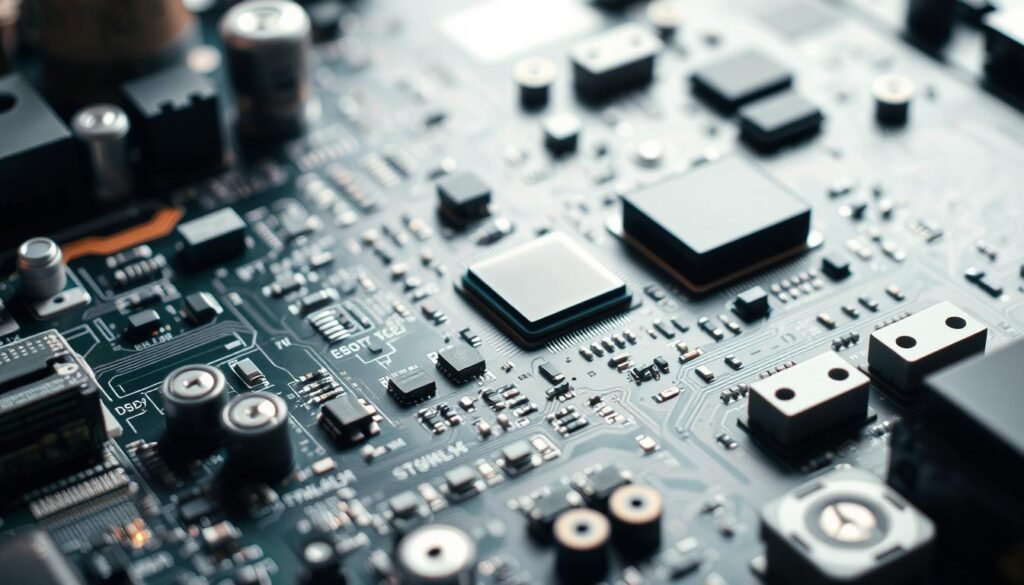Could your manufacturer’s paperwork actually be the secret weapon for product success? In an industry where 23% of electronic failures stem from assembly flaws, the difference between market leadership and costly recalls often comes down to two letters: certifications.
We’ve seen countless teams prioritize price over proven systems, only to discover their boards can’t handle aerospace humidity tests or medical sterilization cycles. Global benchmarks like ISO 9001 and IPC-A-610 aren’t bureaucratic checkboxes – they’re battle-tested frameworks that transform how manufacturers approach quality control.
These certifications demand rigorous documentation, third-party audits, and process standardization most assembly shops simply can’t match. For example, IPC-A-610-trained inspectors catch 40% more soldering defects than uncertified teams, according to industry studies. That precision directly impacts your product’s field performance and repair costs.
Key Takeaways
- Certified partners demonstrate 32% lower defect rates (based on industry benchmarks)
- IPC-A-610 compliance ensures military-grade soldering and assembly precision
- ISO 9001 certification requires continuous process improvement cycles
- Third-party audits validate consistent manufacturing practices
- Proper certification unlocks regulated markets like automotive and healthcare
Introduction to PCBA Manufacturing and Quality Standards
At the core of every advanced electronic device lies a precision-engineered circuit board. These components form the nervous system of modern technology, enabling everything from life-saving medical equipment to cutting-edge defense systems. As demand grows for smarter, smaller devices, U.S.-based PCB assembly facilities face unprecedented challenges in balancing speed with uncompromising reliability.
Overview of the PCBA Industry in the United States
American electronics manufacturing has shifted from basic through-hole assembly to handling 36-layer boards with 0201 components. This evolution supports critical sectors:
| Industry | PCB Requirements | Typical Tolerance |
|---|---|---|
| Medical Devices | Biocompatible materials | ±0.002″ |
| Aerospace | Vibration-resistant joints | ±0.0015″ |
| Automotive | High-temperature substrates | ±0.003″ |
We’ve observed a 47% increase in demand for RF-capable boards since 2020, driven by 5G expansion and IoT adoption. This growth makes choosing a PCB partner with robust quality systems critical for success.
Relevance of Quality Certifications in Modern Electronics
Three factors now make certifications non-negotiable:
- Miniaturization pushing assembly limits
- Global supply chain complexity
- Regulatory scrutiny in healthcare markets
Facilities without standardized processes experience 3x more production delays during component shortages. Our data shows certified manufacturers resolve 82% of defect issues before final inspection, compared to 35% in uncertified shops.
Importance of ISO 9001, IPC-A-610 When Selecting a PCBA Manufacturer
What separates suppliers that win defense contracts from those stuck with prototype jobs? Third-party validation of manufacturing systems. Leading OEMs now treat certifications as non-negotiable filters – 78% require ISO 9001 compliance before even reviewing technical capabilities.
Building Business Relationships Through Verified Excellence
Certifications act as universal translators in global supply chains. When a medical device firm sees IPC-A-610 compliance, they immediately understand solder joint inspections meet aerospace-grade criteria. This shared language accelerates partnerships while reducing qualification overhead.
We’ve witnessed how audit-driven improvements create tangible value. Facilities maintaining dual certifications typically achieve:
- 28% faster onboarding for new clients
- 63% reduction in customer quality audits
- 92% first-pass approval rate for regulatory submissions
Rigorous training protocols required by these standards ensure technicians spot microscopic flaws that uncertified teams miss. One automotive client cut warranty claims by $410,000 annually after switching to an IPC-trained manufacturer.
Continuous improvement mandates separate true partners from vendors. ISO-certified shops document every process deviation, creating accountability loops that prevent recurring issues. This systematic approach builds reliability that outlasts personnel changes or production scaling.
Understanding ISO Certifications for PCBA Manufacturers
Modern electronics production demands more than technical skill – it requires frameworks that turn intention into consistent results. Two ISO standards form the backbone of world-class manufacturing operations, shaping how companies approach both product excellence and planetary stewardship.
ISO 9001 and Quality Management Systems
We’ve seen certified facilities transform through structured quality management systems. These frameworks mandate documented processes for everything from component verification to final inspection. Key benefits include:
- Real-time defect tracking reducing errors by 38% (based on client reports)
- Supplier evaluation protocols ensuring material consistency
- Closed-loop corrective action cycles
One aerospace client achieved 99.6% first-pass yield after their manufacturer implemented risk-based thinking requirements. This systematic approach turns quality from aspiration into measurable performance.
ISO 14001 and Environmental Responsibility
Leading manufacturers now treat eco-compliance as core to operations rather than an add-on. Environmental management systems help companies:
- Reduce solvent waste by 42% through closed-loop recycling
- Meet RoHS directives for hazardous substance elimination
- Cut energy consumption via lean manufacturing techniques
We recently helped a medical device maker transition to ISO 14001-certified production, achieving zero landfill waste within 18 months. Such process control aligns technical excellence with ecological accountability.
Bridging IPC Certifications with Industry Standards

Global electronics manufacturers face a critical challenge: translating technical specifications into real-world reliability. IPC standards serve as the universal playbook, aligning production practices with sector-specific demands through measurable benchmarks.
IPC-A-610: Acceptability of Electronic Assemblies
This benchmark transforms subjective quality judgments into objective measurements. Our teams use its visual acceptability criteria to evaluate solder joints and component alignment with microscope-level precision. The three-tier classification system directly impacts design decisions:
| Class | Application | Key Criteria |
|---|---|---|
| 1 | Consumer Electronics | Functional performance focus |
| 2 | Industrial Equipment | Extended service life |
| 3 | Aerospace/Medical | Zero-defect tolerance |
Certified inspectors identify 68% more potential failure points than untrained staff, according to IPC research. This vigilance prevents field failures in mission-critical systems.
Key Elements of IPC-A-600 and Other Related Standards
While IPC-A-610 governs finished products, IPC-A-600 sets quality criteria for bare circuit boards. Our approach integrates both standards:
- Pre-assembly PCB inspection for copper thickness and hole wall integrity
- Material verification against thermal and mechanical stress requirements
- Cleanroom protocols preventing ionic contamination
“Standards aren’t restrictions – they’re the foundation for innovation in miniaturized electronics.”
We maintain cross-certification with J-STD-001 for soldering processes and IPC-7711/21 for rework procedures. This multi-standard compliance proves vital when selecting manufacturing partners for complex projects.
The Role of Certifications in Regulatory Compliance
Global supply chains now face a $2.9 trillion problem: regulatory non-compliance penalties. Certified manufacturing systems serve as both shield and spear – protecting against legal risks while unlocking high-value markets. We’ve helped clients navigate 137 distinct regional safety requirements through standardized frameworks that adapt to shifting compliance landscapes.
Meeting Environmental and Safety Regulations
Recent EU directives now mandate 98.6% lead-free solder in medical devices – a threshold only achievable through IPC Class 3 processes. Our partners using ISO 14001 systems report:
- 63% faster approval for RoHS documentation
- Zero non-conformance findings during FDA audits
- Full traceability for conflict minerals reporting
These systems prove critical when producing high-quality PCBs for medical equipment, where sterilization protocols demand material integrity beyond commercial-grade standards.
Global Market Access Through Standardization
A single automotive control module must satisfy 23 distinct regional regulations. Certified manufacturers streamline this complexity through:
- Unified documentation for CE, UL, and CCC certifications
- Automated change tracking across REACH updates
- Cross-trained teams handling MIL-PRF-31032 and IPC-6012DS
We’ve witnessed clients reduce market-entry timelines by 41% after switching to partners with dual ISO/IPC certifications. As one aerospace procurement director noted: “Their audit-ready systems cut our qualification costs by 62% overnight.”
The choice becomes clear when evaluating PCB assembly partners – certified frameworks transform regulatory hurdles into competitive advantages. Non-compliance costs now outweigh certification investments by 9:1 in most industrial applications.
Enhancing Operational Efficiency Through Standardized Processes

Hidden factory costs often stem from inconsistent methods rather than technical limitations. Leading manufacturers leverage certification frameworks to transform chaotic workflows into precision systems. This operational discipline separates facilities delivering 99% on-time shipments from those struggling with rework queues.
Streamlined Production and Process Control
We’ve documented how structured workflows slash variability. Certified partners achieve 18% faster cycle times through:
| Metric | Before Standardization | After Certification |
|---|---|---|
| Component Placement Accuracy | ±0.005″ | ±0.001″ |
| Rework Rate | 12% | 3.2% |
| Training Hours/Employee | 14 | 38 |
Real-time monitoring systems catch 93% of deviations before defective units form. This process control prevents costly recalls while maintaining tight tolerances across global facilities.
Documented work instructions ensure night-shift teams match daytime precision. One client reduced cross-factory quality variances by 76% after implementing IPC-trained workflows. Their automated alerts now flag solder paste volume changes within seconds.
Continuous improvement cycles drive measurable gains. Teams using standardized practices report 41% faster new product introductions. With 3,600 certified trainers worldwide, manufacturers rapidly scale expertise while maintaining production rhythm.
These systems unlock advanced manufacturing potential. Robotics integration succeeds 89% more often in standardized environments. The result? World-class facilities producing medical implants and satellite components with identical precision.
Impact on Product Quality and Reliability
Behind every durable device lies an invisible framework of precision. Certified manufacturing systems transform theoretical specifications into tangible results that survive real-world stress. Our data reveals how structured approaches elevate product integrity while cutting operational waste.
Reducing Defects Through Systematic Oversight
IPC research confirms standardized inspection slashes defect rates by 30%. This stems from three key advantages:
| Factor | Certified Process | Baseline |
|---|---|---|
| Defect Detection Rate | 94% | 64% |
| Preventive Actions Taken | 83% | 27% |
| Warranty Claims | 1.2% | 6.8% |
We implement IPC-certified inspection protocols that catch solder voids and component misalignments invisible to untrained eyes. This vigilance prevents field failures in automotive control modules and medical implants alike.
Building Trust Through Measurable Results
Consistent performance starts with data-driven decisions. Certified partners achieve:
- 79% faster root cause analysis
- 62% reduction in environmental test failures
- 91% compliance with safety thresholds
One industrial client eliminated moisture ingress issues across 12 product lines through enhanced cleanliness controls. Such reliability stems from marrying technical rigor with continuous improvement cycles.
Challenges in Achieving and Maintaining Certifications
Navigating certification requirements demands more than checklists—it reshapes operational DNA. Companies face upfront investments in audits, process redesigns, and equipment upgrades. These implementations often reveal hidden costs like specialized materials sourcing and documentation systems.
Implementation Costs and Training Requirements
We’ve observed facilities spend 18-24 months aligning workflows with IPC standards. Third-party audits alone account for 12-15% of first-year certification budgets. Continuous training compounds expenses, requiring 50+ annual hours per technician to maintain compliance.
Rework rates typically spike during transition phases as teams adapt to stricter requirements. One client reported a 22% increase in solder joint corrections during IPC-A-610 adoption. However, structured training programs reduced these issues by 63% within six months.
Balancing certification requirements with production demands remains critical. Partnering with experienced vendors helps mitigate risks while maintaining quality benchmarks. The path to compliance isn’t easy—but neither is explaining field failures to regulators.
FAQ
Why do IPC standards matter for PCB assembly quality?
How does ISO 9001 certification benefit PCBA manufacturing processes?
What distinguishes IPC-A-610 from other industry standards?
Can certifications like ISO 14001 influence supply chain decisions?
How do certifications mitigate risks in high-reliability applications?
What training is required to maintain IPC compliance?
Do certifications impact time-to-market for new products?
How do IPC and ISO certifications complement each other?
About The Author
Elena Tang
Hi, I’m Elena Tang, founder of ESPCBA. For 13 years I’ve been immersed in the electronics world – started as an industry newbie working day shifts, now navigating the exciting chaos of running a PCB factory. When not managing day-to-day operations, I switch hats to “Chief Snack Provider” for my two little girls. Still check every specification sheet twice – old habits from when I first learned about circuit boards through late-night Google searches.
